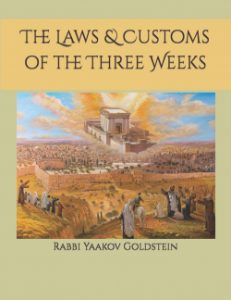
Introduction
The name of the month-Menachem Av:[1]
The name Av: The Akkadian meaning of the word Av possibly is wood. The Hebrew meaning of the word is father, as this month is the head of all tragedies.[2]
The name Menachem: The name Menachem is an integral part of the name of the month of Av. This extends to the ruling that if a document had only the name Menachem written and not the name Av, it is valid.[3] This term emphasizes the comforting of the father, Hashem during this month.
Month of mercy:[4]
The month of Av is a month of mercy. The term father represents mercy, as the verse states Av Harachaman. This does not contradict the terrible tragedies that occurred in this month, as the tragedies occurred in order to chastise the Jewish people and bring them back to the path of G-d. It is similar to a merciful father who disciplines his son.
Important dates in the month of Av:
The death of Aaron: Aaron passed away on Rosh Chodesh Menachem Av [in the year 2488].[5] Aaron was known for being a peacemaker amongst families and friend and one is hence to emulate his actions especially in this month.[6]
The 5th of Av: The Arizal passed away on the 5th day of Menachem Av. This is an auspicious day for the brining of the redemption.[7]
The seventh of Av: On the 7th day of Menachem Av, the gentiles entered the Heichal.[8] One is to increase in his pleas for the redemption on this day.[9]
Important dates after the 9th of Av: See Chapter 7!
Shabbos Chazon:
The Shabbos prior to Tisha B’av is cordially known as Shabbos Chazon. It is called this name after the title of the Haftorah of this Shabbos, Chazon Yeshayahu. In addition, there is a tradition from Reb Hillel of Paritch, in name of Rav Levi Yitzchak of Berditchiv that on this Shabbos Hashem shows the soul of every Jew a distant spiritual vision of the third Temple.[10] The purpose of this vision is to help increase a Jew’s anticipation for the redemption. Although this matter effects one’s inner soul, subconsciously, it is further increased through contemplating this matter on this Shabbos.[11] The reason Hashem shows us the Third Temple specifically the Shabbos before Tisha B’av is to express to us that in truth the purpose of the exile is to bring about the great revelation of the Third Temple.[12]
Directives of the Rebbe applicable to the nine days:
Increasing in charity:[13] One is to increase in distribution of charity during the nine days, as the verse[14] states that Tziyon will be redeemed with Mishpat and its exiles with Tzedaka.
Increasing in Torah learning:[15] One is to increase in Torah learning throughout the period of the nine days, as the verse[16] states that Tziyon will be redeemed with Mishpat and its exiles with Tzedaka. One should study the laws of mourning relevant to the three weeks, nine days, and Tisha B’av.
Organizing a Siyum Misechta:[17] Throughout the nine days one is to organize a Siyum Mesechta to take place daily, in order to increase in the permitted forms of Simcha during this time, and hasten the Siyum of the Galus. The masses should participate in these Siyumim, and the Misayem should explain the conclusion of the Tractate in a way that all can understand. One can choose a simple and short Misechta for this purpose, such as Miseches Tamid, which only has eight pages. It is proper to arrange Siyumim over the radio. One is to hold a Siyum even on Erev Tisha B’av and Tisha B’av, of those Tractates permitted to be studied. On Motzei Tisha B’av one is to arrange a second Siyum, in addition to the one held on Tisha B’av.[18] A Siyum is also to be held on the 10th of Av. One is to make mention by these Siyumim of the need to increase in Ahavas Yisrael and charity.
_______________________________________________[1] See Likkutei Sichos 23:215
[2] Midrash Hasheimos ibid
[3] Get Pashut 126:35, brought in Pischeiy Teshuvah 126:12; Aruch Hashulchan 126:16
[4] Sefer Hamamarim Nachamu 5670
[5] Bamidbar 20:28; Michaber 580:1; Tur 580
[6] Likkutei Sichos 24:334
[7] Hisvadyus 5749 4:117
[8] Taanis 29a
[9] Hisvadyus 5759 4:122
[10] Brought in Reshimos of Tzemach Tzedek on Eicha p. 45
[11] See Likkutei Sichos 9:24; Hisvadyus 5747 4:165
[12] Hisvadyus 5749 4:100; 5750 4:89
[13] Likkutei Sichos 24:334
[14] Yeshaya 1:27
[15] Likkutei Sichos 24:334; Hisvadyus 5748 2:564
[16] Yeshaya 1:27
[17] Likkutei Sichos 24:334; Hisvadyus 5748 2:564; Sichos Kodesh 5740 Matos Maasei; The custom of the Rebbe Rashab was to make a Siyum Misechta throughout the nine days, although he did not eat meat or drink wine at the occasion. [Sefer Haminhagim p. 46]
[18] Hisvadyus 1989 4 p. 94



Leave A Comment?
You must be logged in to post a comment.